- 1Extreme Light Infrastructure–Nuclear Physics, Horia Hulubei National Institute for R&D in Physics and Nuclear Engineering (IFIN-HH), Măgurele, Romania
- 2Center for Nuclear Study (CNS), University of Tokyo, Wako, Japan
When we think of clustering in nuclear physics, the astrophysical importance within light nuclei and structural manifestations with classical analogs immediately come to mind. 4He, also known as the alpha particle, is the most abundant nucleus in the Universe, being quite tightly bound for its mass, with a first excited state of over 20 MeV. The nature of the alpha particle places it in a unique position within nuclear astrophysics and structure (including geometry). The plurality of energy release from stellar hydrogen fusion—whether quiescent or explosive—comes from the conversion of hydrogen to helium. Within more complex nuclei, the alpha particles are continuously arranged, leading to fascinating phenomena such as excited rotational bands, Borromean ring ground states, and linear structures. Nuclei with an equal and even number of protons and neutrons are colloquially referred to as “alpha conjugate nuclei,” where such special properties are the most pronounced and easiest to spot. However, when a single nucleon or a pair of nucleons is added to the system, alpha clustering not only remains evident but it may also be enhanced. Excited states with large alpha partial widths are a signature of clustering behavior, and these states can have a profound effect on the reaction rates in astrophysical systems when the excitation energy aligns with the so-called Gamow energy—the preferential thermal energy to statistically overcome the Coulomb barrier. In this article, we will consider in detail the specific ramifications of alpha clustering in selected scenarios for both nuclear astrophysics and topology. In particular, we discussed the astrophysical reactions of 7Li (α, γ), 7Be+α, 11C (α, p), and 30S (α, p), where α-clusters may increase the reaction rates from 10% to an order of magnitude; large α resonances make the astrophysical rate of 18F (p, α) quite uncertain. We also focused on the α rotational bands of both positive and negative parities of 11B and 11C, and finally on the strongest evidence for the linear-chain cluster state observed in 14C.
1 Introduction
The clustering of α particles in nuclei plays a critical role in both nuclear astrophysics and nuclear structure. Before delving into the topic, we will review the synthesis of several elements in the light and medium mass regions as they pertain to α clusters. We will then discuss by what empirical measurements and which types of experiments are most suitable to discuss α-clusterization. Once the groundwork is laid, we will review works published over the last dozen years on α-clusterization in the following nuclei: 11B, 11C, 14C, 15O, 19Ne, and 34Ar.
Most of the aforementioned nuclei are radioactive, which often requires rare isotope beams (RIBs). However, clusterization has a long history even in stable isotopes. In particular, during the quiescent phases of stellar evolution of a massive star leading to an iron core in pre-collapse Type II supernovae, clusterization may not be limited to α-clusters, as shown in the Cluster Nucleosynthesis Diagram Figure 1, inspired by the Ikeda diagram [1]. In a massive star (10 M⊙) according to one model, the core burning temperature, density, and lifetime are as follows: hydrogen, 37 × 106 K, 3.8 g/cm3, and 7.3 × 106 years; helium, 1.80 × 108 K, 620 g/cm3, and 0.72 × 106 years; carbon, 7.20 × 108 K, 6.4 × 105 g/cm3, and 320 years; neon, 1.9 × 109 K,
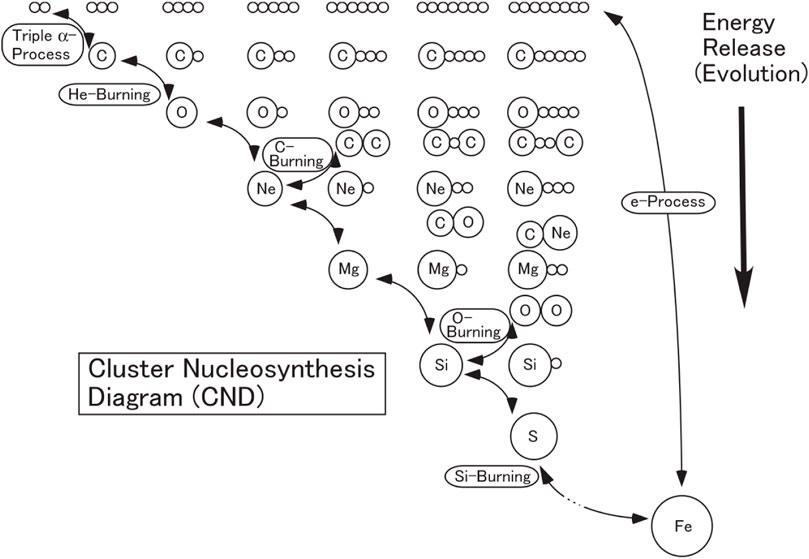
FIGURE 1. Cluster Nucleosynthesis Diagram (CND) [83] for nucleosynthesis during the evolution of a massive star. The small open circles are α-clusters. As the chart starts on the upper left with the lightest elements, energy generation is produced going down, shown on the right side. The image shows in a simple way which nuclei may have clusters. © 1994 Elsevier. Reprinted with permission.
The Wigner limit, W, is frequently encountered in the literature, although it is strongly dependent on the radius, R, without any specific structural information, and there are several definitions. In this article, the maximum width of a resonance can be estimated as follows:
where μ is the reduced mass of the channel, R is the channel radius, and Pℓ is the channel penetrability for channel i [4,5]. The penetrability is calculated as
There are several experiments for determining Γα. Elastic α-scattering has a large cross section, although owing to the Coulomb barrier, elastic scattering of a charged particle rarely shows a resonant structure near the α separation energy, Sα, because of the Rutherford peak. The Trojan horse method is able to measure two-body reactions with extremely low cross sections via a two-to-three-body reaction in a quasi-free kinematics condition [6–8]. α-transfer reactions, such as (6Li, d) or (7Li, t), are also quite good near Sα and even below it for sub-threshold energies to obtain the ANCs of peripheral reactions [9]. Photodisintegration is useful to study the radiative capture on an unstable species when the recoil is stable (Utsunomiya et al. [10]), and moreover, the type and origin of the background differ from those of the radiative capture (Smith et al. [11]). Coulomb dissociation (Baur et al. [12]) and time reversal studies have sizable cross sections and can be used at higher beam energies. In the case when Γα is smaller than another competing partial width, say (α, p) or (α, n) direct measurements, application of the isolated, narrow-resonance condition for the reaction A (i, j)B as
where γ is the reduced width [5] and the smaller partial width controls the contribution to the reaction rate.
Most of the experiments discussed in this paper use an RIB on gaseous helium targets using the thick target in the inverse kinematics (TTIK) technique [13], which has several advantages. First, the intensity of short-lived RIBs is several orders of magnitude less than the primary beam, so the statistics would be very poor using a thin target of implanted helium (Lennard et al. [14]). One way to increase the total yield is obviously using a thicker target. Second, the impinging beam loses significant energy within the target (often times being stopped entirely), and using the kinematic equations, the measured energy of the reaction point and, hence, the beam energy at that point can be deduced if the energy loss functions and the specific reaction are known. Because the reaction of interest is measured over a large range of energy, it, moreover, prevents the time-consuming retuning of the RIB. In this manuscript, all reactions are written in the astrophysical, normal kinematics nomenclature for convenience despite the fact that most of the experiments were performed in inverse kinematics.
2 Rotational bands and astrophysics of 11B and 11C
Lithium, beryllium, and boron are relatively less abundant than other light and medium mass nuclei, and the astrophysical sites of their production and destruction continue to pose challenges today, for example, the cosmological lithium problem (Hou et al. [15]; Hayakawa et al. [16] and references therein). The nuclei 11B and 11C are mirror nuclei, and some excited states show a dilute form of alpha-clusterization as either 2α + t or 2α +3He, respectively [17–19]. Furthermore, both have been observed to have positive- and negative-spin rotational bands, represented as α-clusterization (Yamaguchi et al. [20], Yamaguchi et al. [21] and references therein). These α-clusters can play an essential role in many explosive environments: ν-process, pp-V, rap (II, III, and IV), and the νp-process. The aforementioned processes may be found in a number of stellar environments: supermassive stars with low metallicity, novae, big-bang nucleosynthesis, and core-collapse supernovae. Considering the number of theoretical and experimental studies, the diverse manifestation of α-clusters, and a large range of astrophysical impact, the present review will mainly focus on 7Li (α, α) and 7Be (α, α).
The ν-process occurs in core-collapse supernovae where neutrinos are emitted from the proto–neutron star [22]. In the ν-process, 11B is mainly produced via 4He (ν, ν′p)3H (α, γ)7Li (α, γ)11B, although it can be enhanced by (anti-)neutrino inelastic and breakup reactions on 12C as well. Therefore, a precise measurement of 7Li (α, γ)11B at
An experiment on 7Li+α in inverse kinematics showed only ground-state transitions [20], and the total cross section of 7Li (α, p) was comparable to a normal kinematics experiment [29]. The best-fit R-Matrix parameters are shown in Table 1, although a major enhancement in the reaction rate compared to the Nuclear Astrophysics Compilation of REaction rates (NACRE) was not found [30]. Conversely, in the 7Be+α inverse kinematic experiment, several channels were seen, (α, α0), (α, α1), (α, p0), and (α, p1), measuring the charged particles and gamma rays in coincidence [21]. Freer et al. [31] also carried out a similar experiment, except not separating out the inelastic component. Although the two spectra show a basic similarity of the peak shape and relative location, Freer et al. [31] showed a factor of two to three lower cross sections, and the centroids of the peak structure were shifted down by approximately 500 keV. Yamaguchi et al. [21] were able to explain nearly all the resonances with known peaks rather than introducing new resonances. A factor of approximately 10% enhancement in the reaction rate over NACRE could be expected between 1.5 and 3 GK [30]. Although the experiments do not agree on the exact quantum values, it is clear alpha-clusterization is prominent in both sets of experiments, with the best-fit R-Matrix parameters shown in Table 2. Most recently, Psaltis et al. confirmed the astrophysical reaction rate for 7Be (α, γ) suggested in NACRE II [26, 27, 32] with a significantly improved precision.

TABLE 1. Best-fit resonance parameters of 11B determined by Yamaguchi et al. [20]. Values in italics were fixed to those found in the literature [85,86]. The penetrability limit,
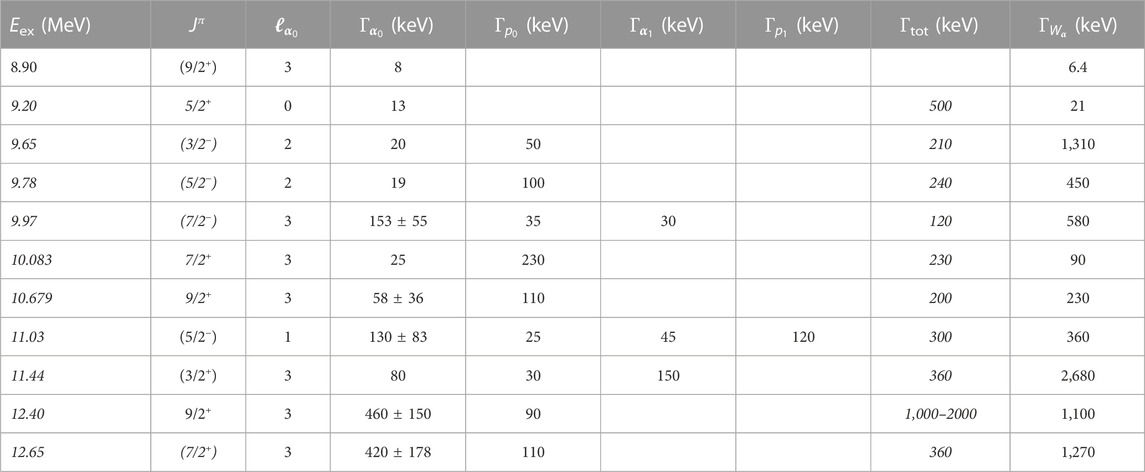
TABLE 2. Best-fit resonance parameters of 11C determined by Yamaguchi et al. [21]. Values in italics were fixed to those found in the literature [85,86]. Other Jπ values are possible but are omitted here. R0 was set to 1.2 fm for
Although the astrophysical reaction rate was not significantly changed by any of these measurements, the rotational bands in 11B and 11C are interesting from a structure perspective. Previously known rotational bands, as well as those found by Yamaguchi et al. are shown in Figures 2, 3. Both the K = 5/2+ and K = 3/2+ bands show a linear dependence of Eex on J (J + 1) and may be related to their oblate, multi-centered α-cluster structure (Soić et al. [33] and references therein). Inspection of the figures indicates mirror levels offset by approximately 500 keV, which diminishes at a higher excitation energy, possibly from a phase transition from the shell model to cluster states (Freer et al. [31] and references therein). It might be strange that the ground state of 11B, which is 3/2−, appears above the 1/2− state, but Ragnarsson et al. [34] found a similar energy of the two states, suggesting the 3/2− state is lower than expected. As the figures show, the negative parity bands in both 11B and 11C do not show a perfect linear correlation, and there is a commonality that the energies of two of the bandheads are lower than expected. A calculation using antisymmetrized molecular dynamics (AMD) qualitatively reproduced these findings, attributing this difference to a weaker interaction between the three-center cluster bandhead compared to a more rigid structure of higher-energy states [35]. Finally, the 9/2+, 12.4-MeV state in 11C observed may be a missing member of the K = 3/2+ band.
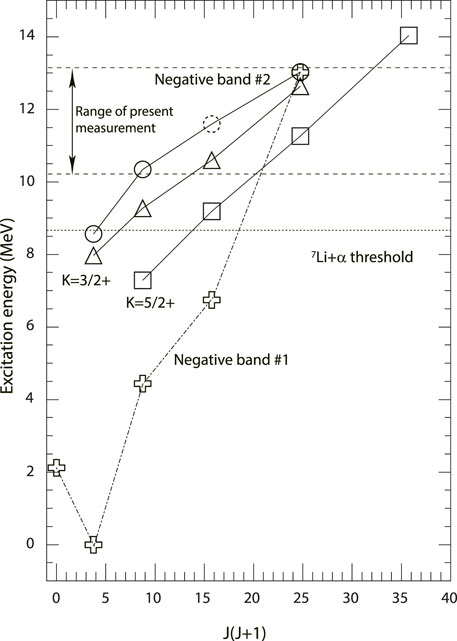
FIGURE 2. Rotational bands in 11B from Yamaguchi et al. [20]. The positive parity bands show very good linearity, whereas the proposed negative parity bands demonstrate some deviance, as described in the text. © 2011 American Physical Society. Reprinted with permission.
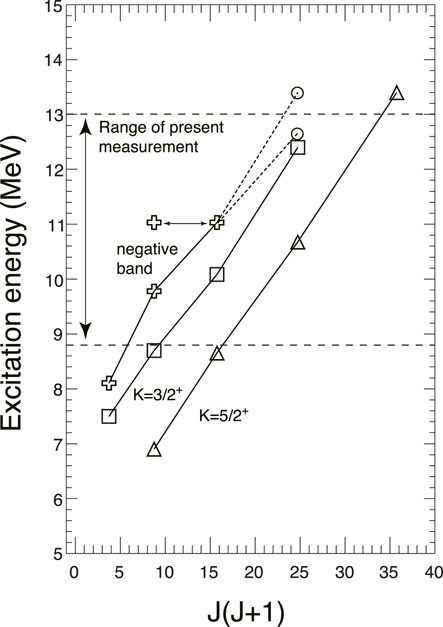
FIGURE 3. Rotational bands in 11C from Yamaguchi et al. [21]. The positive parity bands have excellent linearity, but the proposed negative band shows a non-linear behavior similar to the second negative parity band in 11B in Figure 2. © 2013 American Physical Society. Adapted with permission.
3 Linear state and rotation in 14C
Cluster states where all the clusters fall in a line—the linear-chain cluster state (LCCS)—have been of theoretical interest since the 1950s [36]. Linear clusters are seen in other quantum mechanical systems, such as chemistry. Carbon dioxide (CO2) shows a linear geometry with an atom of carbon covalently double-bonded between two oxygen atoms at 180°; the molecule can rotate and/or vibrate, which are also observed in the nuclear structure. The shapes of nuclei and their excited states have been frequently studied (and even used to explain certain shape isomers), but until the last several years, no experiment had found strong evidence to verify the LCCS in nuclei. From an intuitive perspective, we may think of modeling the nucleus as a pair of atoms, where most of them are joined into one of the clusters and only a small number of nucleons are used to bond them together. Efforts in the cluster shell model of adding a single nucleon to α-conjugate nuclei may, in the future, add multiple nucleons to gain better understanding of this phenomenon [37]. Initial theories on the LCCS looked at α-nuclei like 12C and 16O with no bonding nucleons, but other theoretical topologies better fit the experimental data. For example, the Hoyle state in 12C was found to be either a molecular-like state of 8Be+α or a weak coupling of three α-particles [38], and the 0+ state just above the four-α threshold in 16O showed quenching of the moment of inertia consistent with a superfluid state [39]. Until now, 14C is the only species where the experimental work shows a strong indication of a theoretical LCCS.
Suhara and Kanada-En’Yo [40] proposed a prolate band starting a few MeV above the α threshold of 14C as an LCCS using the AMD method. The wavefunction dominating the LCCS and an intuitive cartoon are shown in Figure 4. The LCCS was demonstrated to be stabilized by orthogonality to underlying states, and it has a nature of Jπ = 0+, 2+, and 4+. Independently, several groups around the world began looking for this LCCS using a 10Be beam on a helium target for elastic scattering [41–43]. Similar to the 7Be case mentioned previously, Freer et al. [41] and Yamaguchi et al. [43] had a reasonable agreement in the spectral shape but the absolute cross sections did not agree. Unlike the case of 7Be, Freer et al. [41] found a cross section about a factor of four higher than Yamaguchi et al. [43]. As Freer et al. [41] used a normalization factor for the absolute cross section and Yamaguchi et al. [43] only relied on the experimental parameters, the latter might be considered more reliable. Similar to 7Be, the peak structure showed less consistency toward the lower energy side, where the energy loss function plays an important role. Although Freer et al. [41] did not find evidence for a prolate rotational band, Yamaguchi et al. [43] found striking similarity in the energy and spin for the LCCS of Suhara and Kanada-En’Yo [40], as shown in Figure 5. Fritsch et al. [42] used an active target but showed deviation from these results, such as much smaller absolute cross sections (even than Rutherford scattering), no goodness of fit between their theoretical and measured Jπ, and a sharp Ec. m. locus for inelastic scattering.
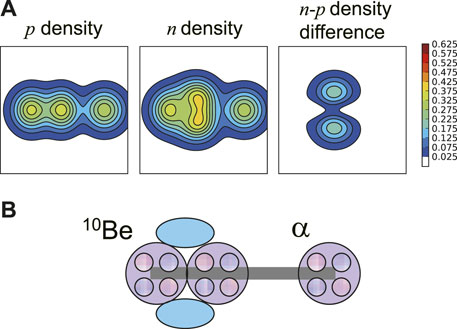
FIGURE 4. Wavefunction of the predominated LCCS determined by the AMD method [40, 84]. (A) Proton density, neutron density, and their difference. (B) Intuitive image of the wavefunction. © 2016 Yamaguchi et al. [43] under the CC BY license.
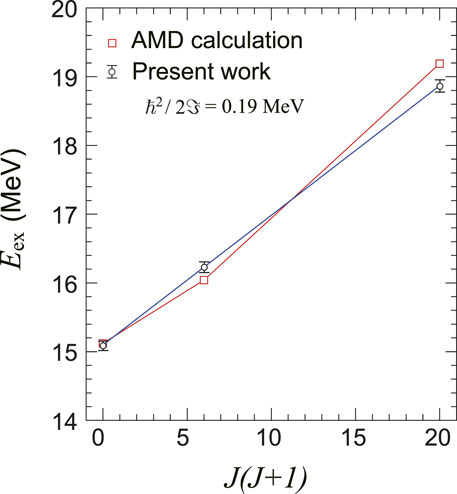
FIGURE 5. Rotational band of the LCCS comparing the AMD calculation [40] to the experimental data [43]. The best R-Matrix fit did not take any guidance from the theory. The agreement between the two is excellent and is strong evidence of an LCCS. © 2016 Yamaguchi et al. [43] under the CC BY license.
Table 3 shows a strong indication of an LCCS, only plotting the relevant states. Although the widths show some differences, their average downward trend is the same. Moreover, it is not straightforward to ascertain
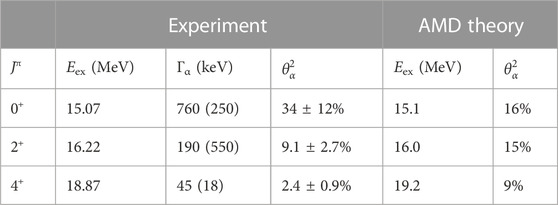
TABLE 3. Selected experimental data on 14C [43] and an AMD calculation predicting an LCCS [40]. R0 was set to 1.34 fm for the experimental
4 Astrophysics of the compound nucleus 15O
The νp-process occurs in the neutrino-driven wind of core-collapse supernovae [24, 25, 45], where owing to the neutrino interactions, the material is actually proton rich similar to the rp-process (Section 6). Light p-nuclei such as 92,94Mo and 96,98Ru, which cannot be explained by other astrophysical sites, might originate from this process. Because of the environment, a sequence like 7Be (α, γ)11C (α, p) can compete with the triple-alpha process to bridge the gap between the pp-chains and the CNO region. In this case, it begins the αp-process, which can increase the energy generation by two or three orders of magnitude in less than one second. However, unlike the rp-process, some longer-lived species such as 56Ni and 64Ge can be bypassed by (n, p) reactions as a small amount of protons are turned into neutrons by neutrino interactions. The amount of the material to be processed depends on bridging the A = 5, 8 mass gaps, requiring knowledge of the 11C (α, p) reaction. Most recently, the 11C (α, p) reaction was found to be one of the two most important processes in the ν-process in core-collapse supernovae Yao et al. [46], as described in Section 2.
Prior to the work on a direct measurement, the compilations relied on the time-reversed reaction 14N (p, α)11C via the activation method [30, 47]. The method is quite successful and determines the 11C (α, p0) rate at all angles, but it does not give any information on excited-state transitions. With a fairly simple setup (Figure 6), Hayakawa et al. [48] measured the (α, p0), (α, p1), and (α, p2) reactions on 11C without gamma-detectors (such as used to separate states in Section 2). The experiment used beam tracking monitors to get a system time-of-flight (TOF) for each incoming beam that coincided with the proton detected using a silicon strip detector. Using the TTIK method, the depth of the beam’s interaction in the target gas determines Ecm, which can be measured by the system TOF. The events are shown in Figure 7 for both high and low energies, where the difference in beam energy is from the energy loss in the second beamline monitor used (multi-channel plate or parallel plate avalanche counter). Protons show loci and the correct gradient along the calculated lines for p0−2, except for broadening toward lower energy, owing to the resolution of the silicon detector.
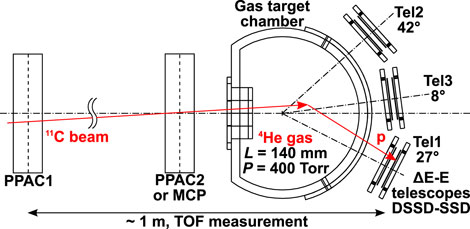
FIGURE 6. Experimental setup for 11C (α, p) using an extended, thick gas cell to allow a measurable time-of-flight (TOF) between the 11C-beam ions and outgoing protons [48], as shown in Figure 7 for Tel1. Two beam monitors and segmented silicon detectors enable a calculation of the precise depth of each interaction. © 2016 American Physical Society. Reprinted with permission.
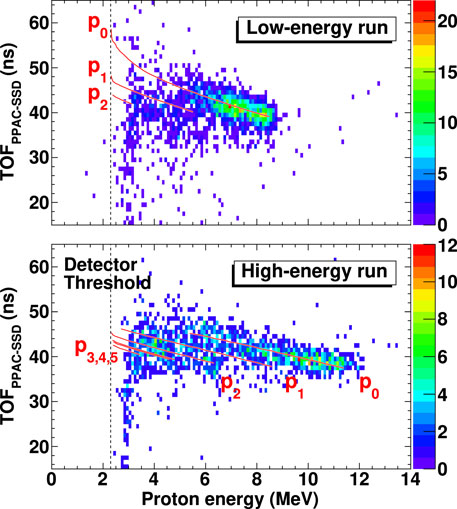
FIGURE 7. Detected energy of protons vs. the relative time-of-flight (TOF) for 11C (α, p) measurement [48] for Tel1 (Figure 6). Simulations for different transitions are shown in red and reproduce the centroids of the loci. © 2016 American Physical Society. Reprinted with permission.
The results show that the (α, p1−2) cross sections were about an order of magnitude lower (maximum 20%) than the (α, p0) rate. The summed reaction rate was higher than compilations as much as 40% [30, 47], specifically due to resonances at 0.9 and 1.35 MeV which were not considered. Conversely, the Hauser–Feshbach statistical rate over-estimates the total experimental rate at low energies but begins to match at higher temperatures [49]. As the Hauser–Feshbach rate suggests only a small difference between (α, p0−2) and the total rate (αall, pall), the experiment has likely measured the main transitions.
No Γα partial widths were previously known. However, the statistics, resolution, and overlapping widths suggested that a new R-Matrix fit to the data was unlikely to bring new information. Some α-elastic scattering was observed at rather high energies but not reported since it was well over the three GK region of known astrophysical importance. Approximately 50 years ago, the α-cluster structure of 15O was studied up to 8 MeV over the α-threshold via the 12C (3He, α)11C and 14N (p, α)11C reactions (Weller [50], Weller [51]; Huttlin and Rollefson [52], and references therein). Weller assumed an α-particle of ℓ = 1 orbital angular momentum couples to one of the states in the 11C core. The lowest-lying cluster states in 15O would have an excitation associated with the α-decay threshold, while higher-lying states are based on excitations of the 11C core and different couplings of the α-particle with the core’s intrinsic angular momenta. To test this theory, Huttlin and Rollefson made higher-energy measurements of 14N (p, α)11C and found some similarities with 12C (3He, α); the study was ultimately inconclusive as definitive spin-parity assignments were unavailable for many states, which began to overlap. Unfortunately, further investigation seems to have waned in both theoretical and experimental work on the α-cluster structure of 15O in the intervening years. Considering the continued astrophysical attention to the 11C (α, p) reaction since the mid-2000s, additional studies of the α-cluster structure of 15O—including reanalysis of old data with modern methods—may be warranted.
5 Subthreshold alpha states in 19Ne
Typically, when a given channel has a significantly smaller width than its competing astrophysical channel, the smaller width dominates the analytic reaction rate, as shown in Eq. 2. However, when a nearby resonance has the same Jπ, these resonances can interfere depending on the widths and sometimes drastically change the reaction probability. In general, it requires a direct measurement as the interference sign cannot otherwise be deduced, but measurements of the widths, spin-parity, and energy can reduce the uncertainty. Such resonances are often outside the Gamow window and can also be the subthreshold. A key example of this case is the α-cluster structure of 19Ne which affects the 18F (p, α) reaction, where the proton threshold is above the α-threshold, but the ℓ = 0 resonances interfere with each other (Jπ = 1/2+, 3/2+) for temperatures below 0.3 GK [53, 54].
Classical novae occur in explosive binary star systems, typically with recurrence times greater than a thousand years. One partner is a white dwarf which accretes matter from a low-mass, less-evolved companion until the accreted material builds up enough pressure to induce thermonuclear runaway in the compact object’s envelope. In addition to supernovae and neutron star mergers, novae are the most powerful thermonuclear explosions in the universe. The 18F (p, α) reaction is one of the few remaining nuclear structure cases where the uncertainty is large enough to influence the outcome of classical novae simulations; the other two cases are 25Al (p, γ) and 30P (p, γ). The 2-h half-life of 18F is comparable to the timescale for the nova ejecta to become transparent to γ radiation, making it an ideal radiotracer of the explosion. Its decay to 18O emits a neutrino and positron, the latter of which annihilates with an electron to form a pair of γ-rays, and is thought to be the main source of 511-keV γ-rays from a nova explosion. However, thus far, no such signal from nearby novae has been detected by a satellite telescope.
From a nuclear physics perspective, it is difficult to calculate the maximum distance to a nova to determine the expected 511-keV flux because the 18F (p, α) rate remains quite uncertain despite nearly three decades of research since 18F was produced as a radioactive beam. Interference between ℓ = 0 states (Jπ = 1/2+, 3/2+) near the proton threshold with higher-lying states is a major source of this uncertainty. There is a well-known 3/2+ resonance at Er = 664.7 keV (Eex = 7.0747 MeV) with Γp = 15.2 keV and Γα = 23.8 keV [55]. A broad 1/2+ state was predicted [56] and also observed by several works near Er ≈ 1.5 MeV but not resolved [53, 57, 58]. A state with ℓ = 0 was resolved at Er = 1.38 (3) with a smaller total width Γ = 130 (10) keV, as shown in Figure 8 [59]. The partial widths of the 1/2+ state remain uncertain, but it was shown that as long as the width is broad, the partial widths of Γp and Γα do not affect the interference pattern [60]. The uncertainty of 30 keV of the state also does influence the magnitude or location of the interference [60]. Enough information on the higher-lying states in 19Ne to constrain the experiment is extant, and so the focus of the community is looking at ℓ = 0 states nearby the proton threshold in addition to pushing the direct measurement to lower energies. According to mirror symmetry, there are two 3/2+ states and one 1/2+ state near the proton separation energy of 19Ne in 19F.
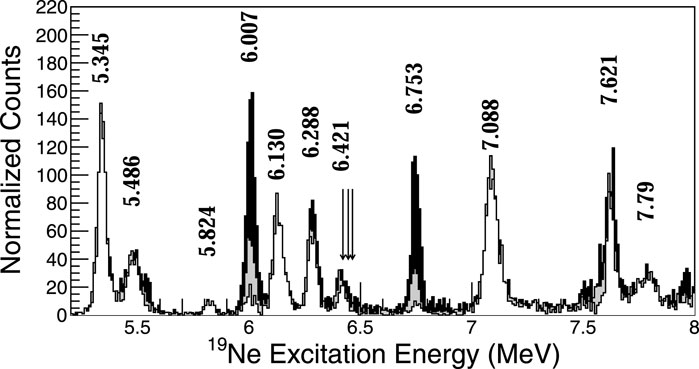
FIGURE 8. Focal plane data from Grand RAIDEN for the 19F (3He, t)19Ne measurement at 420 MeV [59]. Peaks are labeled and shown overlaid from the lowest to the highest angle: Θ = 0.0° − 0.5° (white), Θ = 0.8° − 1.2° (gray), and Θ = 1.6° − 2.0° (black). Peaks at different angles are normalized to the 1/2+, 5.345-MeV state. Δℓ = 0 (Jπ = 1/2+ and 3/2+) states are forward focused and appear white, Δℓ = 1 states appear at larger angles and are black, and a mixture indicates another angular momentum transfer or overlapping states.
Several experiments were published in the last several years [59, 61, 62], which were analyzed by Kahl et al. [60]. Since then, new experiments [63, 64] and further analysis of the existing data were also presented [65, 66]. The subthreshold state at 6.132 (5) MeV was unambiguously identified as an ℓ = 0 transition by a model-independent method, as shown in Figure 8 [59], and its spin-parity in combination with that of Kahl et al. was determined as 3/2+ [64]. Another subthreshold state is approximately 6.29 MeV and was measured to be 1/2+ [67], which is now confirmed as a doublet [59, 61, 64, 68, 69]. It is noted that for low-spin states in this region, the calculated mirror energy displacement (MED) is 70 ± 50 keV [64], and pairing the 6.13 MeV state with a known 3/2+ state in 19F requires an MED of over 350 keV; this may suggest an unknown 3/2+ state in 19F. The final 3/2+ state(s) in this region should be above the proton separation energy, and two such states with tentative assignments were provided by Hall et al. [61] at 6.423 (3) and 6.441 (3) MeV.
The clusters in 19F and 19Ne have been described in terms of oscillator shells including s, p, and sd harmonics [56, 66]. The ℓ = 1 α cluster states (Jπ = 1/2+, 3/2+) are interesting in a comparison with 20Ne, where n = 3 nodes are Pauli-blocked in 16O+α but not in the A = 19 mirror case [66]. A broad 1/2+ state was paired with the 5.94-MeV state in 19F by the generator coordinate method (GCM) [56], and experiments looking for a broad state near 6 MeV in 19Ne have been reported [63]. Twenty years ago, Descouvemont and Baye [70] used the GCM and paired the same state with a resonance at 5.34 MeV in 19F rather than the 5.94-MeV state as they found the energies were up to 1 MeV smaller in experiment vs. theory. If one takes the experiments from Di Leva et al. [71] on 19F and Torresi et al. [72] for 19Ne, it can be seen there may be no missing state from GCM studies, as shown in Table 4. These

TABLE 4. Second GCM states from Dufour and Descouvemont [56] with the spectroscopic factors
The 18F (p, α) reaction requires not only knowledge of 19Ne but also further investigation of its mirror 19F.
6 Astrophysics of the compound nucleus 34Ar
Type I X-ray bursts (XRBs) are similar to classical novae, except the compact object is a neutron star rather than a white dwarf. As such, XRBs are a class of astronomical phenomena where in a binary pair, a low mass star accretes matter onto a neutron star and regular explosions take place. Indeed, there are over 100 known XRBs within our galaxy. Characteristic bursting behavior shows a very sharp rise time (one to 10 s) and then a thermal decline. The energy output is around 1039–1040 ergs for 10–100 s, and the bursts repeat much more frequently than in classical novae, in the order of hours to days, owing to the compactness of the neutron star. The amount of the accreted material per time,
34Ar is, like 14O, an
The only experimental paper to measure Γα in 34Ar is by Kahl et al. [79] using an active target. The center-of-mass energies of that study are near 3 GK, being rather higher than the peak XRB temperature of 1.3–2.0 GK. There have been several theoretical works to determine 30S (α, p), but here, we focus mainly on the experimentally determined values for Γα. Three states with the proposed α-cluster structure were observed between approximately 4.3 and 5.5 MeV, which had

TABLE 5. Best fit level parameters of 34Ar determined by Kahl et al. [79]. The proton width was controlled by the reduced dimensionless partial widths
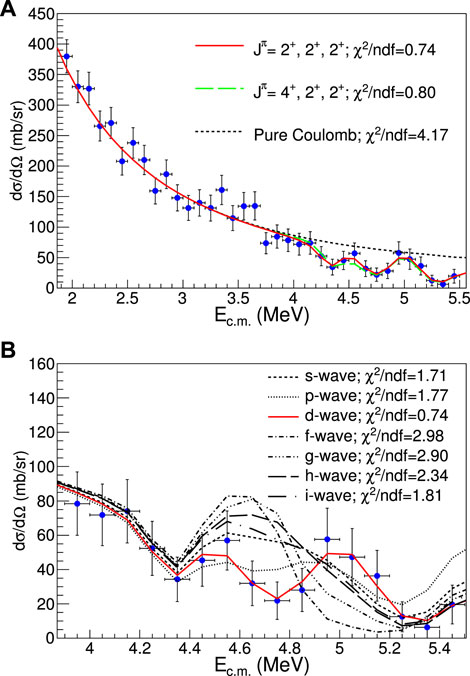
FIGURE 9. 30S+α elastic scattering excitation function including fits from Table 5 [79]. (A) Energy of the entire spectrum; bumps near 3.5 MeV are background-induced. Two R-Matrix fits are compared against pure Coulomb scattering. (B) All physically allowed ℓα values for the Er = 4.78 MeV resonance, showing the unambiguous assignment of ℓ = 2. © 2018 American Physical Society. Reprinted with permission.
The 33Cl (p, α) time-reversal reaction was measured previously to constrain the 30S (α, p) reaction around 3 GK [81]. They found a comparable cross section from the NON-SMOKER code, whereas Kahl et al. [79] found a factor of 10 times increase in the reaction rate compared to the statistical model [49]. The difference could be attributed to Deibel et al [81] measuring the 30S (α0, p0) rate, similar to the case of 11C (α, p). These rates are, as mentioned previously, outside the astrophysical region of interest for XRBs. However, Long et al. [82] performed an 36Ar (p, t) spectroscopy experiment over the XRB Gamow window with 30-keV resolution. No 34Ar states were observed with a width larger than the resolution. Therefore, they estimated Γα for the levels they observed from a shell-model calculation and found a cross section in the astrophysical region of interest significantly lower than that of the NON-SMOKER statistical model. Unfortunately, as the experiment did not overlap with the other two studies, a comparison between their results at different energies is not possible. More experiments to measure Γα in 34Ar and also 30S (α, p) at astrophysical energies are certainly warranted. According to the data in Table 5, Γα either dominates or contributes strongly to the 30S (α, p) resonant reaction rate (at least at higher temperatures). A confirmation of the total widths of these states would be helpful to rule out contributions from Γp.
7 Conclusion
We presented studies on several nuclei both from a nuclear astrophysics and/or structural perspective. Alpha-clusters are found in a variety of lighter-mass species on both sides of the valley of stability. Although most of the works call for future studies, we emphasize that it is not necessarily finding alpha-clusters in the atomic nuclei but why. It is hard to imagine that alpha-clusters do not play an essential role in the nuclear structure, particularly in light nuclei. Yet, simply identifying them without an overarching framework would likely lead to a preponderance of data, looking for a good model or scenario to justify. We showed that the application of alpha-clusters in the selected nuclei spread over a large, somewhat mutually exclusive, domain.
For high-temperature astrophysical reactions like (α, γ), α, clusters may be involved, but typically, Γγ has the smallest width and thus, dominates the rate. On the other hand, for (α, p) reactions, despite clusterization, which leads to large Γα values, these reduced widths may be quite important even if Γp is just a few percentage of the Wigner limit. We infer a similar situation is true with (α, n) reactions but did not review them. Sometimes, from the interference between states of the same Jπ, often from the α-width, it can have a huge impact on the lower energy rate like 18F (p, α), and the interference sign cannot be predicted by theory. We found that positive parity, α-cluster rotational bands show an excellent linearity, whereas negative parity bands require deeper understanding for the non-linear structure. Finally, we reviewed the strongest experimental evidence for an experimental linear-chain cluster state in 14C.
Author contributions
DK came up with the conception and design of the study at the suggestion of HY. DK wrote the manuscript draft. DK, HY, and SH commented on the draft and are responsible for revisions to the submitted version. All authors contributed to the article and approved the submitted version.
Funding
This work was carried out under the contract PN 23.21.01.06 sponsored by the Romanian Ministry of Research, Innovation and Digitalization and JSPS KAKENHI (nos 19K03883 and 23H01181), and the Ministry of Education, Culture, Sports, Science and Technology (MEXT) of Japan.
Conflict of interest
The authors declare that the research was conducted in the absence of any commercial or financial relationships that could be construed as a potential conflict of interest.
Publisher’s note
All claims expressed in this article are solely those of the authors and do not necessarily represent those of their affiliated organizations, or those of the publisher, the editors, and the reviewers. Any product that may be evaluated in this article, or claim that may be made by its manufacturer, is not guaranteed or endorsed by the publisher.
References
1. Ikeda K, Takigawa N, Horiuchi H. The systematic structure-change into the molecule-like structures in the self-conjugate $4n$ nuclei. Prog Theor Phys Supp (1968) 68:464–75. doi:10.1143/ptps.e68.464
2. Chiosi C. Stellar nucleosynthesis and chemical evolution of galaxies. EAS Publications Ser (2007) 27:25–39. doi:10.1051/eas:200714225C
3. Hoyle F. On nuclear reactions occuring in very hot stars. I. The synthesis of elements from carbon to nickel. Astrophys J Supp (1954) 1:121–46. doi:10.1086/190005
6. Baur G. Breakup reactions as an indirect method to investigate low-energy charged-particle reactions relevant for nuclear astrophysics. Phys Lett B (1986) 178:135–8. doi:10.1016/0370-2693(86)91483-8
7. Tribble RE, Bertulani CA, La Cognata M, Mukhamedzhanov AM, Spitaleri C. Indirect techniques in nuclear astrophysics: A review. Rep Prog Phys (2014) 77:106901. doi:10.1088/0034-4885/77/10/106901
8. Spitaleri C, La Cognata M, Lamia L, Mukhamedzhanov AM, Pizzone RG. Nuclear astrophysics and the Trojan horse method. Eur Phys J A (2016) 52:77. doi:10.1140/epja/i2016-16077-2
9. Mukhamedzhanov AM, Tribble RE. Connection between asymptotic normalization coefficients, subthreshold bound states, and resonances. Phys Rev C (1999) 59:3418–24. doi:10.1103/PhysRevC.59.3418
10. Utsunomiya H, Katayama S, Gheorghe I, Imai S, Yamaguchi H, Kahl D, et al. Photodisintegration of 9Be through the 1/2+ state and cluster dipole resonance. Phys Rev C (2015) 92:064323. doi:10.1103/PhysRevC.92.064323
11. Smith R, Gai M, Stern SR, Schweitzer DK, Ahmed MW. Precision measurements on oxygen formation in stellar helium burning with gamma-ray beams and a Time Projection Chamber. Nat Comm (2021) 12:5920. doi:10.1038/s41467-021-26179-x
12. Baur G, Bertulani CA, Rebel H. Coulomb dissociation as a source of information on radiative capture processes of astrophysical interest. Nucl Phys A (1986) 458:188–204. doi:10.1016/0375-9474(86)90290-3
13. Artemov KP, Belyanin OP, Vetoshkin AL, Wolskj R, Golovkov MS, Gol’dberg VZ, et al. Effective method of study of alpha-cluster states. Sov J Nucl Phys (1990) 52:408–11.
14. Lennard WN, Geissel H, Alexander TK, Hill R, Jackson DP, Lone MA, et al. Depth profiles of 35 keV 3He ions in metals. Nucl Instr Meth Phys Res B (1985) 10:592–5. doi:10.1016/0168-583X(85)90315-5
15. Hou SQ, He JJ, Parikh A, Kahl D, Bertulani CA, Kajino T, et al. Non-extensive statistics to the cosmological lithium problem. Astrophys J (2017) 834:165. doi:10.3847/1538-4357/834/2/165
16. Hayakawa S, La Cognata M, Lamia L, Yamaguchi H, Kahl D, Abe K, et al. Constraining the primordial lithium abundance: New cross section measurement of the 7Be + n reactions updates the total 7Be destruction rate. Astrophys J (2021) 915:L13. doi:10.3847/2041-8213/ac061f
17. Tohsaki A, Horiuchi H, Schuck P, Röpke G. Alpha cluster condensation in 12C and 16O. Phys Rev Lett (2001) 87:192501. doi:10.1103/PhysRevLett.87.192501
18. Kawabata T, Akimune H, Fujimura H, Fujita H, Fujita Y, Fujiwara M, et al. Isovector and isoscalar spin-flip M1 strengths in 11B. Phys Rev C (2004) 70:034318. doi:10.1103/PhysRevC.70.034318
19. Kawabata T, Akimune H, Fujita H, Fujita Y, Fujiwara M, Hara K, et al. 2 α + t cluster structure in 11B. Phys Lett B (2007) 646:6–11. doi:10.1016/j.physletb.2006.11.079
20. Yamaguchi H, Hashimoto T, Hayakawa S, Binh DN, Kahl D, Kubono S, et al. α resonance structure in 11B studied via resonant scattering of 7Li+α. Phys Rev C (2011) 83:034306. doi:10.1103/PhysRevC.83.034306
21. Yamaguchi H, Kahl D, Wakabayashi Y, Kubono S, Hashimoto T, Hayakawa S, et al. α-resonance structure in 11C studied via resonant scattering of 7Be+α and with the 7Be(α,p) reaction. Phys Rev C (2013) 87:034303. doi:10.1103/PhysRevC.87.034303
22. Yoshida T, Kajino T, Yokomakura H, Kimura K, Takamura A, Hartmann DH. Supernova neutrino nucleosynthesis of light elements with neutrino oscillations. Phys Rev Lett (2006) 96:091101. doi:10.1103/PhysRevLett.96.091101
23. Wiescher M, Gorres J, Graff S, Buchmann L, Thielemann F-K. The hot proton-proton chains in low-metallicity objects. Astrophys J (1989) 343:352–64. doi:10.1086/167709
24. Fröhlich C, Martínez-Pinedo G, Liebendörfer M, Thielemann F-K, Bravo E, Hix WR, et al. Neutrino-Induced nucleosynthesis of A>64 nuclei: The νp process. Phys .Rev Lett (2006) 96:142502. doi:10.1103/PhysRevLett.96.142502
25. Wanajo S. The rp-process in neutrino-driven winds. Astrophys J (2006) 647:1323–40. doi:10.1086/505483
26. Psaltis A, Chen AA, Longland R, Connolly DS, Brune CR, Davids B, et al. Direct measurement of resonances in 7Be(α,γ)11C relevant to ν p -process nucleosynthesis. Phys Rev Lett (2022) 129:162701. doi:10.1103/PhysRevLett.129.162701
27. Psaltis A, Chen AA, Longland R, Connolly DS, Brune CR, Davids B, et al. First inverse kinematics measurement of resonances in 7Be(α,γ)11C relevant to neutrino-driven wind nucleosynthesis using DRAGON. Phys Rev C (2022) 106:045805. doi:10.1103/PhysRevC.106.045805
28. Kelley JH, Kwan E, Purcell JE, Sheu CG, Weller HR. Energy levels of light nuclei. Nuc Phys A (2012) 880:88–195. doi:10.1016/j.nuclphysa.2012.01.010
30. Angulo C, Arnould M, Rayet M, Descouvemont P, Baye D, Leclercq-Willain C, et al. A compilation of charged-particle induced thermonuclear reaction rates. Nucl Phys A (1999) 656:3–183. doi:10.1016/S0375-9474(99)00030-5
31. Freer M, Achouri NL, Angulo C, Ashwood NI, Bardayan DW, Brown S, et al. Resonances in 11C observed in the 4He(7Be,α)7Be and 4He(7Be,p)10B reactions. Phys Rev C (2012) 85:014304. doi:10.1103/PhysRevC.85.014304
32. Xu Y, Takahashi K, Goriely S, Arnould M, Ohta M, Utsunomiya H. NACRE II: An update of the NACRE compilation of charged-particle-induced thermonuclear reaction rates for nuclei with mass number A<16. Nuc Phys A (2013) 918:61–169. doi:10.1016/j.nuclphysa.2013.09.007
33. Soić N, Freer M, Donadille L, Clarke NM, Leask PJ, Catford WN, et al. α-decay of excited states in 11C and 11B. Nucl Phys A (2004) 742:271–90. doi:10.1016/j.nuclphysa.2004.06.027
34. Ragnarsson I, Åberg S, Hakansson HB, Sheline RK. Application of the cranked Nilsson model in some light nuclei: The super backbend in 11B and 11C? Nucl Phys A (1981) 361:1–22. doi:10.1016/0375-9474(81)90468-1
35. Suhara T, Kanada-En’yo Y. Cluster structures in 11B. Phys Rev C (2012) 85:054320. doi:10.1103/PhysRevC.85.054320
36. Morinaga H. Interpretation of some of the excited states of 4n self-conjugate nuclei. Phys Rev (1956) 101:254–8. doi:10.1103/PhysRev.101.254
37. Della Rocca V, Iachello F. Cluster shell model: I. Structure of 9Be. 9B Nucl Phys A (2018) 973:1–32. doi:10.1016/j.nuclphysa.2018.02.003
38. Horiuchi H. Many-cluster problem by the orthogonality condition model –general discussion and 12C problem. Prog Theor Phys (1975) 53:447–60. doi:10.1143/PTP.53.447
39. Ohkubo S, Hirabayashi Y. α-particle condensate states in 16O. Phys Lett B (2010) 684:127–31. doi:10.1016/j.physletb.2009.12.066
40. Suhara T, Kanada-En’Yo Y. Cluster structures of excited states in 14C. Phys Rev C (2010) 82:044301. doi:10.1103/PhysRevC.82.044301
41. Freer M, Malcolm JD, Achouri NL, Ashwood NI, Bardayan DW, Brown SM, et al. Resonances in 14C observed in the 4He(10Be,α)10Be reaction. Phys Rev C (2014) 90:054324. doi:10.1103/PhysRevC.90.054324
42. Fritsch A, Beceiro-Novo S, Suzuki D, Mittig W, Kolata JJ, Ahn T, et al. One-dimensionality in atomic nuclei: A candidate for linear-chain α clustering in 14C. Phys Rev C (2016) 93:014321. doi:10.1103/PhysRevC.93.014321
43. Yamaguchi H, Kahl D, Hayakawa S, Sakaguchi Y, Abe K, Nakao T, et al. Experimental investigation of a linear-chain structure in the nucleus 14C. Phys Lett B (2017) 766:11–6. doi:10.1016/j.physletb.2016.12.050
44. Kanada-En’yo Y, Suhara T, Taniguchi Y. Approximation of reduced width amplitude and application to cluster decay width. Prog Theor Exp Phys (2014) 2014:073D02. doi:10.1093/ptep/ptu095
45. Pruet J, Hoffman RD, Woosley SE, Janka H-T, Buras R. Nucleosynthesis in early supernova winds. II. The role of neutrinos. Astrophys J (2006) 644:1028–39. doi:10.1086/503891
46. Yao X, Kusakabe M, Kajino T, Cherubini S, Hayakawa S, Yamaguchi H. Supernova nucleosynthesis, radioactive nuclear reactions and neutrino-mass hierarchy. Eur Phys J W Conf (2022) 260:01007. doi:10.1051/epjconf/202226001007
47. Caughlan GR, Fowler WA. Thermonuclear reaction rates V. Atom Data Nucl Data Tab (1988) 40:283–334. doi:10.1016/0092-640X(88)90009-5
48. Hayakawa S, Kubono S, Kahl D, Yamaguchi H, Binh DN, Hashimoto T, et al. First direct measurement of the 11C(α, p)14N stellar reaction by an extended thick-target method. Phys Rev C (2016) 93:065802. doi:10.1103/PhysRevC.93.065802
49. Rauscher T, Thielemann F-K. Astrophysical reaction rates from statistical model calculations. Atom Data Nucl Data Tab (2000) 75:1–351. doi:10.1006/adnd.2000.0834
50. Weller HR. Observation of alpha-particle core-excited threshold states in 15O. Phys Lett B (1969) 30:409–11. doi:10.1016/0370-2693(69)90474-2
51. Weller HR. Observation of α-particle core-excited threshold states in light nuclei. Phys Rev Lett (1972) 28:247–9. doi:10.1103/PhysRevLett.28.247
52. Huttlin GA, Rollefson AA. Alpha-cluster levels in 15O as seen in the reaction 14N(p,α0)11C. Phys Rev C (1974) 9:576–80. doi:10.1103/physrevc.9.576
53. Dalouzy JC, Achouri L, Aliotta M, Angulo C, Benhabiles H, Borcea C, et al. Discovery of a new broad resonance in 19Ne: Implications for the destruction of the cosmic γ-ray emitter 18F. Phys Rev Lett (2009) 102:162503. doi:10.1103/PhysRevLett.102.162503
54. Chae KY, Bardayan DW, Blackmon JC, Gregory D, Guidry MW, Johnson MS, et al. First experimental constraints on the interference of 3/2+ resonances in the 18F(p, α)15O reaction. Phys Rev C (2006) 74:012801. doi:10.1103/PhysRevC.74.012801
55. Bardayan DW, Blackmon JC, Bradfield-Smith W, Brune CR, Champagne AE, Davinson T, et al. Destruction of 18F via 18F(p,α)15O burning through the Ec.m.=665 keV resonance. Phys Rev C (2001) 63:065802. doi:10.1103/PhysRevC.63.065802
56. Dufour M, Descouvemont P. The 18F(p, α) 15O low-energy S-factor: A microscopic approach. Nucl Phys A (2007) 785:381–94. doi:10.1016/j.nuclphysa.2006.12.101
57. Adekola AS, Brune CR, Bardayan DW, Blackmon JC, Chae KY, Cizewski JA, et al. 19Ne levels studied with the 18F(d,n)19Ne*(18F+p) reaction. Phys Rev C (2012) 85:037601. doi:10.1103/PhysRevC.85.037601
58. Mountford DJ, Murphy ASJ, Achouri NL, Angulo C, Brown JR, Davinson T, et al. Resonances in 19Ne with relevance to the astrophysically important 18F(p,α)15O reaction. Phys Rev C (2012) 85:022801. doi:10.1103/PhysRevC.85.022801
59. Kahl D, Woods PJ, Fujita Y, Fujita H, Abe K, Adachi T, et al. s-wave resonances for the 18F(p, α)15O reaction in novae. Eur Phys J A (2019) 55:4. doi:10.1140/epja/i2019-12682-9
60. Kahl D, José J, Woods PJ. Uncertainties in the 18F(p, α)15O reaction rate in classical novae. Astron Astrophys (2021) 653:A64. doi:10.1051/0004-6361/202140339
61. Hall MR, Bardayan DW, Baugher T, Lepailleur A, Pain SD, Ratkiewicz A, et al. Key 19Ne states identified affecting γ-ray emission from 18F in novae. Phys Rev Lett (2019) 122:052701. doi:10.1103/PhysRevLett.122.052701
62. La Cognata M, Fisichella M, Pietro Di A, Figuera P, Goldberg VZ, Cherubini S, et al. Observation of 15N+α resonant structures in 19F using the thick target in inverse kinematics scattering method. Phys Rev C (2019) 99:034301. doi:10.1103/PhysRevC.99.034301
63. Riley JE, Laird AM, de Séréville N, Parikh A, Fox SP, Hammache F, et al. Sub-threshold states in 19Ne relevant to 18F(p,α)15O. Phys Rev C (2021) 103:015807. doi:10.1103/PhysRevC.103.015807
64. Portillo F, Longland R, Cooper AL, Hunt S, Laird AM, Marshall C, et al. Spin-parities of subthreshold resonances in the 18F(p,α)15O reaction. Phys Rev C (2023) 107:035809. doi:10.1103/PhysRevC.107.035809
65. Goldberg VZ, Nurmukhanbetova AK, Volya A, Nauruzbayev DK, Serikbayeva GE, Rogachev GV. α -cluster structure in 19F and 19Ne in resonant scattering. Phys Rev C (2022) 105:014615. doi:10.1103/PhysRevC.105.014615
66. Volya A, Goldberg VZ, Nurmukhanbetova AK, Nauruzbayev DK, Rogachev GV. Lowest-energy broad α -cluster resonances in 19F. Phys Rev C (2022) 105:014614. doi:10.1103/PhysRevC.105.014614
67. Bardayan DW, Chipps KA, Ahn S, Blackmon JC, deBoer RJ, Greife U, et al. The first science result with the JENSA gas-jet target: Confirmation and study of a strong subthreshold 18F(p, α)15O resonance. Phys Lett B (2015) 751:311–5. doi:10.1016/j.physletb.2015.10.073
68. Laird AM, Parikh A, Murphy ASJ, Wimmer K, Chen AA, Deibel CM, et al. Is γ-ray emission from novae affected by interference effects in the 18F(p,α)15O reaction? Phys Rev Lett (2013) 110:032502. doi:10.1103/PhysRevLett.110.032502
69. Parikh A, Laird AM, de Séréville N, Wimmer K, Faestermann T, Hertenberger R, et al. Spectroscopy of 19Ne for the thermonuclear 15O(α, γ)19Ne and 18F(p, α)15O reaction rates. Phys Rev C (2015) 92:055806. doi:10.1103/PhysRevC.92.055806
70. Descouvemont P, Baye D. Microscopic study of α+15N cluster structure in 19F. Nucl Phys A (1987) 463:629–43. doi:10.1016/0375-9474(87)90635-X
71. Di Leva A, Imbriani G, Buompane R, Gialanella L, Best A, Cristallo S, et al. Measurement of 1323 and 1487 keV resonances in 15N(α,γ)19F with the recoil separator ERNA. Phys Rev C (2017) 95:045803. doi:10.1103/PhysRevC.95.045803
72. Torresi D, Wheldon C, Kokalova T, Bailey S, Boiano A, Boiano C, et al. Evidence for 15O+α resonance structures in 19Ne via direct measurement. Phys Rev C (2017) 96:044317. doi:10.1103/PhysRevC.96.044317
73. Wallace RK, Woosley SE. Explosive hydrogen burning. Astrophys J Supp (1981) 45:389–420. doi:10.1086/190717
74. Parikh A, José J, Moreno F, Iliadis C. The effects of variations in nuclear processes on type I X-ray burst nucleosynthesis. Astrophys J Supp (2008) 178:110–36. doi:10.1086/589879
75. Taam RE. X-ray bursts from thermonuclear runaways on accreting neutron stars. Astrophys J (1980) 241:358–66. doi:10.1086/158348
76. Iliadis C, Endt PM, Prantzos N, Thompson WJ. Explosive hydrogen burning of 27Si, 31S, 35Ar, and 39Ca in novae and X-ray bursts. Astrophys J (1999) 524:434–53. doi:10.1086/307778
77. Fisker JL, Thielemann F-K, Wiescher M. The nuclear reaction waiting points: 22Mg, 26Si, 30S, and 34Ar and bolometrically double-peaked type I X-ray bursts. Astrophys J (2004) 608:L61–4. doi:10.1086/422215
78. Cyburt RH, Amthor AM, Heger A, Johnson E, Keek L, Meisel Z, et al. Dependence of X-ray burst models on nuclear reaction rates. Astrophys J (2016) 830:55. doi:10.3847/0004-637x/830/2/55
79. Kahl D, Yamaguchi H, Kubono S, Chen AA, Parikh A, Binh DN, et al. First measurement of 30S+α resonant elastic scattering for the 30S(α,p) reaction rate. Phys Rev C (2018) 97:015802. doi:10.1103/PhysRevC.97.015802
80. Yamaya T, Saitoh M, Fujiwara M, Itahashi T, Katori K, Suehiro T, et al. Cluster structure in 40Ca via the α-transfer reaction. Nucl Phys A (1994) 573:154–72. doi:10.1016/0375-9474(94)90019-1
81. Deibel CM, Rehm KE, Figueira JM, Greene JP, Jiang CL, Kay BP, et al. First measurement of the 33Cl(p,α)30S reaction. Phys Rev C (2011) 84:1–6. doi:10.1103/PhysRevC.84.045802
82. Long AM, Adachi T, Beard M, Berg GPA, Couder M, deBoer RJ, et al. α-unbound levels in 34Ar from 36Ar(p,t)34Ar reaction measurements and implications for the astrophysical 30S(α,p)33Cl reaction rate. Phys Rev C (2018) 97:054613. doi:10.1103/PhysRevC.97.054613
83. Kubono S. Nuclear clustering aspects in astrophysics. Zeit Phys A (1994) 349:237–40. doi:10.1007/BF01288966
84. Suhara T, Kanada-En’yo Y. Be-α correlations in the linear-chain structure of C isotopes. Phys Rev C (2011) 84:024328. doi:10.1103/PhysRevC.84.024328
85. Ajzenberg-Selove F. Energy levels of light nuclei A = 11-12. Nucl Phys A (1990) 506:1–158. doi:10.1016/0375-9474(90)90271-M
86. Tilley DR, Kelley JH, Godwin JL, Millener DJ, Purcell JE, Sheu CG, et al. Energy levels of light nuclei. Nucl Phys A (2004) 745:155–362. doi:10.1016/j.nuclphysa.2004.09.059
Keywords: nuclear astrophysics, alpha clusters, radioactive beams, Wigner limit, rotational bands
Citation: Kahl D, Yamaguchi H and Hayakawa S (2023) Alpha clustering in nuclear astrophysics and topology. Front. Phys. 11:1189040. doi: 10.3389/fphy.2023.1189040
Received: 18 March 2023; Accepted: 05 July 2023;
Published: 01 September 2023.
Edited by:
Paul Stevenson, University of Surrey, United KingdomReviewed by:
Robin Smith, Sheffield Hallam University, United KingdomFrancesco Giovanni Celiberto, Bruno Kessler Foundation (FBK), Italy
Copyright © 2023 Kahl, Yamaguchi and Hayakawa. This is an open-access article distributed under the terms of the Creative Commons Attribution License (CC BY). The use, distribution or reproduction in other forums is permitted, provided the original author(s) and the copyright owner(s) are credited and that the original publication in this journal is cited, in accordance with accepted academic practice. No use, distribution or reproduction is permitted which does not comply with these terms.
*Correspondence: Daid Kahl, ZGFpZHhvckBnbWFpbC5jb20=
 Daid Kahl
Daid Kahl Hidetoshi Yamaguchi
Hidetoshi Yamaguchi Seiya Hayakawa
Seiya Hayakawa